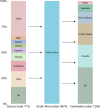South Africa and the Surgical Diaspora-A Hub for Surgical Migration and Training
- PMID: 37029798
- PMCID: PMC10083063
- DOI: 10.1007/s00268-023-06990-x
South Africa and the Surgical Diaspora-A Hub for Surgical Migration and Training
Abstract
Background: The shortage of trained surgeons, anesthesiologists, and obstetricians is a major contributor to the unmet need for surgical care in low- and middle-income countries, and the shortage is aggravated by migration to higher-income countries.
Methods: We performed a cross-sectional observational study, combining individual-level data of 43,621 physicians from the Health Professions Council of South Africa with data from the registers of 14 high-income countries, and international statistics on surgical workforce, in order to quantify migration to and from South Africa in both absolute and relative terms.
Results: Of 6670 surgeons, anesthesiologists, and obstetricians in South Africa, a total of 713 (11%) were foreign medical graduates, and 396 (6%) were from a low- or middle-income country. South Africa was an important destination primarily for physicians originating from low-income countries; 2% of all surgeons, anesthesiologists, and obstetricians from low- and middle-income countries were registered in South Africa, and 6% in the other 14 recipient countries. A total of 1295 (16%) South African surgeons, anesthesiologists, and obstetricians worked in any of the 14 studied high-income countries.
Conclusion: South Africa is an important regional hub for surgical migration and training. A notable proportion of surgical specialists in South Africa were medical graduates from other low- or middle-income countries, whereas migration out of South Africa to high-income countries was even larger.
© 2023. The Author(s).
Conflict of interest statement
Mark Shrime reports consulting fees from Global Surgery Advisors. All other authors report no conflict of interest.
Figures






References
-
- Taylor AL, Dhillon IS (2011) The WHO Global Code of Practice on the International Recruitment of Health Personnel: the evolution of global health diplomacy. Global Health Governance
Publication types
MeSH terms
LinkOut - more resources
Full Text Sources

